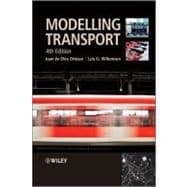
Note: Supplemental materials are not guaranteed with Rental or Used book purchases.
Purchase Benefits
What is included with this book?
Professor Juan de Dios Ortúzar currently works for the Department of Transport Engineering and Logistics, Pontificia Universidad, Chile. He has over 30 years experience as an academic and advisor on transport modelling and social project evaluation. He has fostered the development of discrete choice models and its application to determining willingness-to-pay for reducing transport externalities.
Luis G. Willumsen currently works as Technical Director for the transport planning consultancy Steer Davies Gleave in London. Luis has over thirty year of experience as a consultant, transport planner and researcher with a distinguished academic career. As an Information Technology specialist Luis has been involved in research into electronic toll collection, image processing techniques, incident detection, computer-assisted design of roundabouts and the development of expert systems for bus priority schemes.
Preface.
1 Introduction.
1.1 Transport Planning and Modelling.
1.2 Characteristics of Transport Problems.
1.3 Modelling and Decision Making.
1.4 Issues in Transport Modelling.
1.5 The Structure of the Classic Transport Model.
1.6 Continuous Transport Planning.
1.7 Theoretical Basis Versus Expedience.
2 Mathematical Prerequisites.
2.1 Introduction.
2.2 Algebra and Functions.
2.3 Matrix Algebra.
2.4 Elements of Calculus.
2.5 Elementary Mathematical Statistics.
3 Data and Space.
3.1 Basic Sampling Theory.
3.2 Errors in Modelling and Forecasting.
3.3 Basic Data-Collection Methods.
3.4 Stated Preference Surveys.
3.5 Network and Zoning Systems.
Exercises.
4 Trip Generation Modelling.
4.1 Introduction.
4.2 Regression Analysis.
4.3 Cross-Classification or Category Analysis.
4.4 Trip Generation and Accessibility.
4.5 The Frequency Choice Logit Model.
4.6 Forecasting Variables in Trip Generation Analysis.
4.7 Stability and Updating of Trip Generation Parameters.
Exercises.
5 Trip Distribution Modelling.
5.1 Definitions and Notation.
5.2 Growth-Factor Methods.
5.3 Synthetic or Gravity Models.
5.4 The Entropy-Maximising Approach.
5.5 Calibration of Gravity Models.
5.6 The Tri-proportional Approach.
5.7 Other Synthetic Models.
5.8 Practical Considerations.
Exercises.
6 Modal Split and Direct Demand Models.
6.1 Introduction.
6.2 Factors Influencing the Choice of Mode.
6.3 Trip-end Modal-split Models.
6.4 Trip Interchange Heuristics Modal-split Models.
6.5 Synthetic Models.
6.6 Direct Demand Models.
Exercises.
7 Discrete Choice Models.
7.1 General Considerations.
7.2 Theoretical Framework.
7.3 The Multinomial Logit Model (MNL).
7.4 The Nested Logit Model (NL).
7.5 The Multinomial Probit Model.
7.6 The Mixed Logit Model.
7.7 Other Choice Models and Paradigms
8 Specification and Estimation of Discrete Choice Models.
8.1 Introduction.
8.2 Choice-Set Determination.
8.3 Specification and Functional Form.
8.4 Statistical Estimation.
8.5 Estimating the Multinomial Probit Model.
8.6 Estimating the Mixed Logit Model.
8.7 Modelling with Stated-Preference Data.
Exercises.
9 Model Aggregation and Transferability.
9.1 Introduction.
9.2 Aggregation Bias and Forecasting.
9.3 Confidence Intervals for Predictions.
9.4 Aggregation Methods.
9.5 Model Updating or Transferance.
Exercises.
10 Assignment.
10.1 Basic Concepts.
10.2 Traffic Assignment Methods.
10.3 All-or-nothing Assignment.
10.4 Stochastic Methods.
10.5 Congested Assignment.
10.6 Public-Transport Assignment.
10.7 Limitations of the Classic Methods.
10.8 Practical Considerations.
Exercises.
11 Equilibrium and Dynamic Assignment.
11.1 Introduction.
11.2 Equilibrium.
11.3 Transport System Equilibrium.
11.4 Traffic Dynamics.
11.5 Departure Time Choice and Assignment.
Exercises.
12 Simplified Transport Demand Models.
12.1 Introduction.
12.2 Sketch Planning Methods.
12.3 Incremental Demand Models.
12.4 Model Estimation from Traffic Counts.
12.5 Marginal and Corridor Models.
12.6 Gaming Simulation.
Exercises.
13 Freight Demand Models.
13.1 Importance.
13.2 Factors Affecting Goods Movements.
13.3 Pricing Freight Services.
13.4 Data Collection for Freight Studies.
13.5 Aggregate Freight Demand Modelling.
13.6 Disaggregate Approaches.
13.7 Some Practical Issues.
14 Activity Based Models.
14.1 Introduction.
14.2 Activities, Tours and Trips.
14.3 Tours, Individuals and Representative Individuals.
14.4 The ABM System.
14.5 Population Synthesis.
14.6 Monte Carlo and Probabilistic Processes.
14.7 Structuring Activities and Tours.
14.8 Solving ABM.
14.9 Refining Activity or Tour Based Models.
14.10 Extending Random Utility Approaches.
15 Key Parameters, Planning Variables and Value Functions.
15.1 Forecasting Planning Variables.
15.2 Land-Use Transport Interaction Modelling.
15.3 Car-Ownership Forecasting.
15.4 The Value of Travel Time.
15.5 Valuing External Effects of Transport.
Exercises.
16 Pricing and Revenue.
16.1 Pricing, Revenue and Forecasting.
16.2 Private Sector Projects.
16.3 Risk.
16.4 Demand Modelling.
16.5 Risk Analysis.
16.6 Concluding Remarks.
References.
Index.
The New copy of this book will include any supplemental materials advertised. Please check the title of the book to determine if it should include any access cards, study guides, lab manuals, CDs, etc.
The Used, Rental and eBook copies of this book are not guaranteed to include any supplemental materials. Typically, only the book itself is included. This is true even if the title states it includes any access cards, study guides, lab manuals, CDs, etc.